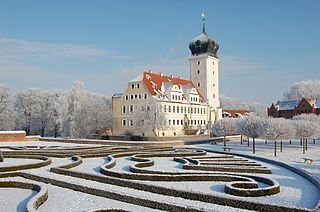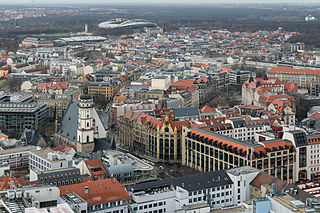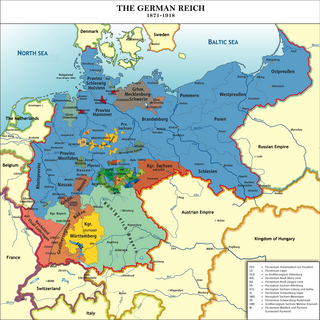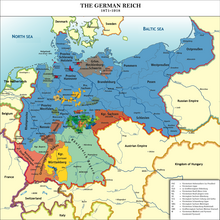
Saxony, officially the Free State of Saxony, is a landlocked state of Germany, bordering the states of Brandenburg, Saxony-Anhalt, Thuringia, Bavaria, as well as the countries of Poland and the Czech Republic. Its capital is Dresden, and its largest city is Leipzig. Saxony is the tenth largest of Germany's sixteen states, with an area of 18,413 square kilometres (7,109 sq mi), and the sixth most populous, with more than 4 million inhabitants.

Thuringia, officially the Free State of Thuringia, is a state of central Germany, covering 16,171 square kilometres (6,244 sq mi), the sixth smallest of the sixteen German states. It has a population of about 2.1 million.

Saxony-Anhalt is a state of Germany, bordering the states of Brandenburg, Saxony, Thuringia and Lower Saxony. It covers an area of 20,451.7 square kilometres (7,896.4 sq mi) and has a population of 2.17 million inhabitants, making it the 8th-largest state in Germany by area and the 11th-largest by population. Its capital is Magdeburg and its largest city is Halle (Saale).

Dessau is a district of the independent city of Dessau-Roßlau in Saxony-Anhalt at the confluence of the rivers Mulde and Elbe, in the Bundesland of Saxony-Anhalt. Until 1 July 2007, it was an independent city. The population of Dessau is 67,747.

The history of Saxony-Anhalt began with Old Saxony, which was conquered by Charlemagne in 804 and transformed into the Duchy of Saxony within the Carolingian Empire. Saxony went on to become one of the so-called stem duchies of the German Kingdom and subsequently the Holy Roman Empire which formed out of the eastern partition of the Carolingian Empire. The duchy grew to become a powerful state within the empire, ruling over much of what is now northern Germany, but following conflicts with the emperor it was partitioned into numerous minor states, including the Principality of Anhalt, around the end of the 12th century and early 13th century. The territories of the Duchy of Saxony, the Principality of Anhalt, and their successors are now part of the modern German state of Saxony-Anhalt.

The Province of Saxony, also known as Prussian Saxony, was a province of the Kingdom of Prussia and later the Free State of Prussia from 1816 until 1944. Its capital was Magdeburg.

Delitzsch is a town in Saxony in Germany, 20 km north of Leipzig and 30 km east of Halle (Saale). With 24,850 inhabitants at the end of 2015, it is the largest town in the district of Nordsachsen.
Mitteldeutscher Rundfunk, shortened to MDR, is the public broadcaster for the federal states of Thuringia, Saxony and Saxony-Anhalt in Germany. Established in January 1991, its headquarters are in Leipzig, with regional studios in Dresden, Erfurt and Magdeburg. MDR is a member of the ARD consortium of public broadcasters in Germany.

The Central German Metropolitan Region is one of the officially established metropolitan regions in Germany. It is centered on the major cities of Leipzig and Halle, extending over Central German parts of the states of Saxony-Anhalt, Thuringia and Saxony. The Central German metropolitan region is the only one located entirely within the former East Germany. The "region" is not actually a metropolitan area in the geographic sense of the word as an agglomeration of nearby urban areas, rather it is a registered association, the Europäische Metropolregion Mitteldeutschland e.V. whose membership is composed of towns, cities, municipalities, and companies, colleges and chambers of commerce in the central German geographic area, whose representatives vote upon new members. For example, Jena joined the Metropolitan Region in 2009. The registered association owns the management company Metropolregion Mitteldeutschland Management GmbH. As such it forms a planning and marketing framework for the region while retaining the legal independence of its members.
The Konferenz Nationaler Kultureinrichtungen (KNK) or Conference of National Cultural Institutions is a union of more than twenty cultural organizations in the former East Germany. It was established in 2002 in Halle.

The Central German football championship was the highest association football competition in Central Germany, in what is now the federal states of Saxony, Saxony-Anhalt and Thuringia, established in 1902. The competition was disbanded in 1933 with the rise of the Nazis to power.

The Magdeburg–Leipzig railway is a double-track, electrified railway in the German states of Saxony-Anhalt and Saxony, connecting Magdeburg via Köthen and Halle to Leipzig.

The Trebnitz–Leipzig railway is a double track electrified main line in the German states of Saxony-Anhalt and Saxony built and originally operated by the Berlin-Anhalt Railway Company. It formally starts at Trebnitz on the former border between the Duchy of Anhalt and Prussia and runs via Dessau and Delitzsch to Leipzig. The section from Bitterfeld to Leipzig is part of Line 1 of the Trans-European Transport Networks (TEN-T). Until 1871, the Zerbst–Roßlau section was called the Anhaltische Leopoldsbahn.

Dessau Hauptbahnhof is the main passenger station in the city of Dessau-Roßlau in the German state of Saxony-Anhalt.

S-Bahn Mitteldeutschland represents an enlargement of the previous Leipzig-Halle S-Bahn. It is an electric rail public transit system operating in the metropolitan area of Leipzig-Halle, Germany. This S-Bahn network developed from two separate S-Bahn networks of Halle (Saale) and Leipzig, which were established separately in 1969 and then linked in 2004. With the opening of the Leipzig City Tunnel on 15 December 2013 as a new artery, the network was extended for the first time to the federal states of Thuringia and Brandenburg. With a system length of 802 km (498 mi), it is the largest S-Bahn network in Germany, displacing the long-time title holder Rhine-Ruhr S-Bahn from that position. The locomotive-hauled double-decker trains partly dating back to the DDR-era have been largely replaced by electric multiple unit Bombardier Talent 2 trains, but some are still used during rush hour.
The abolition of Prussia took place on 25 February 1947 through a decree of the Allied Control Council, the governing body of post-World War II occupied Germany and Austria. The rationale was that by doing away with the state that had been at the center of German militarism and reaction, it would be easier to preserve the peace and for Germany to develop democratically.

Merseburg Hauptbahnhof is the main station of the town of Merseburg in the German state of Saxony-Anhalt. It is located on the Halle–Bebra railway and Deutsche Bahn assigns it to category 4. Merseburg is located in the tariff area of the Mitteldeutscher Verkehrsverbund.

The State of Saxony-Anhalt was a subdivision of the Soviet occupation zone and state of East Germany which broadly corresponds with the present-day German state Saxony-Anhalt. After the retreat of the US troops from the Western parts - following the agreements of the Yalta Conference - it was formed as administrative division called Province of Saxony by the Soviet Military Administration in Germany (SMAD) in July 1945. The province was a re-establishment of the Province of Saxony which existed in Prussia from 1816 to 1944. On 1 July 1944, the Province of Saxony was divided along the lines of its three government districts of Halle-Merseburg, Magdeburg and Erfurt. The two provinces became part of the new state including small parts of Thuringia (Allstedt) and Soviet-occupied parts of Anhalt (Dessau) and Brunswick. Following the first election for the Landtag in October 1946, the state was renamed to Province of Saxony-Anhalt on the same day. With the abolition of Prussia in February 1947, it was named State of Saxony-Anhalt. Compared to the administrative divisions of Nazi Germany, it comprised the Gaue Magdeburg-Anhalt, Halle-Merseburg and small parts of Southern Hanover-Brunswick and Thuringia.

The Mitteldeutscher Verkehrsverbund (MDV) is a transport association in the German Leipzig-Halle (Saale) area. The company is based in Halle (Saale), but its head office is in Leipzig.

















